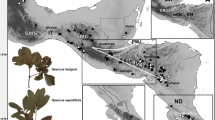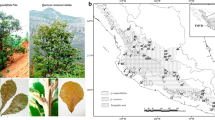Abstract
Holly oak is the only evergreen oak possessing a circum-Mediterranean range; it has two predominant morphological forms, calliprinos and coccifera, described in the eastern and western Mediterranean Basin respectively. The concordance of allozyme and morphotype variation was analysed in the whole holly oak range, and the most plausible historical events responsible for the current geographic pattern of genetic variation were investigated. Individuals from 24 populations were scored for allozyme variation at seven polymorphic loci. Multi-locus genotypes were analysed by using a correspondence analysis (CA) and a Bayesian clustering approach. The relative positions of the populations were obtained from multi-dimensional scaling coupled with UPGMA treatment. A continuous genotype distribution was observed in the CA, and two groups were identified using the Bayesian approach. With a 0.95 threshold, 66 and 69% of the individuals showing the calliprinos and the coccifera morphotypes respectively were assigned to the corresponding genetic groups, which differed by private alleles. As compared to coccifera, the genetic group calliprinos was characterized by higher allelic richness and a strong geographical genetic structure. In agreement with fossil records, the most parsimonious explanation for lack of geographical structure in coccifera is a substantial regression of holly oak in the western Mediterranean Basin during the glaciations and a fast westward post-glacial expansion of coccifera populations, probably from Greece. Two population groups were obtained from the scaling/UPGMA treatment. One included all of the calliprinos populations and a Greek coccifera population, suggesting that the two morphotypes are closely related genetically and constitute two components of the same species.




Similar content being viewed by others
References
Albaladejo RG, Aparicio A (2007) Population genetic structure and hybridization patterns in the Mediterranean endemics Phlomis lychnitis and P. crinita (Lamiaceae). Ann Bot 100:735–746
Anon. (1989) Biomeco (version 3.7). Groupe de biométrie, Centre d’Ecologie Fonctionnelle et Evolutive. CNRS, Montpellier, France
Arnold ML (2006) Evolution through genetic exchange. Oxford University Press, New York
Aronson J, Blondel J (1999) Biology and wildlife of the Mediterranean Region. Oxford University Press, New York
Balakrishnan V, Shangvi LD (1968) Distance between populations on the basis of attribute data. Biometrics 24:859–865
Belkhir K, Borsa P, Chikli L, Raufaste N, Bonhomme F (2001) GENETIX, logiciel sous Windows TM pour la génétique des populations. Laboratoire genome, populations, interactions CNRS UMR 5000, UMII, Montpellier
Benabid A (1984) Étude phytoécologique des peuplements forestiers et pré-forestiers du Rif centro-occidental (Maroc). Trav Instit Sci Rabat sér Bot 34:1–64
Benzecri JP (1973) L’analyse des données II. L’analyse des correspondances. Dunod, Paris
Bottema S, Van Zeist W (1981) Palynological evidence for the climatic history of the near east, 50,000–6,000 BP. Coll Internat CNRS 598:111–132
Browicz K (1986) Quercus aucheri Jaub. et Spach and its range of occurrence. Arbor Kórnickie Rocznik 31:3–11
Brullo S, Marcenò C (1985) Contributo alla conoscenza della classe Quercetea ilicis in Sicilia. Notiz Fitosociol 19:183–229
Camus A (1938) Les chênes, monographie du genre Quercus, vol 3. Lechevallier, Paris
Catarino FM, Correia OCA, Correia AIVD (1982) Structure and dynamics of Serra da Arrábida Mediterranean vegetation. Ecol Medit 8:203–222
Davis PH (1982) Flora of Turkey and the east Aegean Islands. University Press, Edinburgh
El Hamrouni A (1992) Végétation forestière et préforestière de Tunisie : typologie et éléments de gestion. PhD Thesis, Université d’Aix-Marseille III, Aix-en-Provence
Elenga H, Peyron O, Bonnefille R, Jolly D, Cheddadi R, Guiot J, Andrieu V, Bottema S, Bucher G, de Beaulieu JL, Hamilton AC, Maley J, Marchant R, Perez-Obiol R, Reille M, Riollet G, Scott L, Straka H, Taylor D, Van Campo E, Vincens A, Laarif F, Jonson H (2000) Pollen-based biome reconstruction for southern Europe and Africa 18,000 year BP. J Biogeogr 27:621–634
Escoufier Y (1975) Le positionnement multidimentional. Rev Stat Appl 4:5–14
Evanno G, Regnaut S, Goudet J (2005) Detecting the number of clusters of individuals using the software structure: a simulation study. Mol Ecol 14:2611–2620
Hamrick JL (1983) The distribution of genetic variation within and among natural plant populations. In: Schonewald-Cox CM, Chambers SM, MacBryde B, Thomas WL (eds) Genetics and conservation: a reference for managing wild animal and plant populations. Cummings, Menlo Park, pp 335–348
Ikeda H, Setoguchi H (2006) Phylogeography of Arcterica nana (Ericaceae) suggests another range expansion history of Japanese alpine plants. J Plant Res 119:489–495
Ikeda H, Senni K, Fujii N, Setoguchi H (2008) Post-glacial range fragmentation is responsible for current distribution of Potentilla matsumurae Th. Wolf (Rosaceae) in the Japanese archipelago. J Biogeogr 35:791–800
Kvacek Z, Walther H (1989) Paleobotanical studies in Fagaceae of the European Tertiary. Plant Syst Evol 162:213–229
Lagercrantz U, Ryman N (1990) Genetic structure of Norway spruce (Picea abies): concordance of morphological and allozymic variation. Evolution 44:38–53
Lebreton P, Barbero M, Quézel P (2001) Contribution morphométrique et biochimique à la structuration et à la systématique du complexe spécifique chêne vert Quercus ilex L. Acta Bot Gal 148:289–317
López de Heredia U, Carrión JS, Jiménez P, Collada C, Gil L (2007a) Molecular and palaeobotanical evidence for multiple glacial refugia for evergreen oaks on the Iberian Peninsula. J Biogeogr 34:1505–1517
López de Heredia U, Jiménez P, Collada C et al (2007b) Multi-marker phylogeny of three evergreen oaks reveal vicariant patterns in the Western Mediterranean. Taxon 56:1209–1220
Lumaret R, Mir C, Michaud H, Raynal V (2002) Phylogeographical variation of chloroplast DNA in holm oak (Quercus ilex L.). Mol Ecol 11:2327–2336
Lumaret R, Ouazzani N, Michaud H, Vivier G, Deguilloux MF, Di Giusto F (2004) Allozyme variation of oleaster populations (wild olive tree) (Olea europaea L.) in the Mediterranean Basin. Heredity 92:343–351
Maire R (1961) Flore de l’Afrique du Nord (Maroc, Algérie, Tunisie, Tripolitaine, Cyrénaïque et Sahara). Lechevallier, Paris
Michaud H, Toumi L, Lumaret R, Li TX, Romane F, Di Giusto F (1995) Effect of geographical discontinuity on genetic variation in Quercus ilex L. (holm oak). Evidence from enzyme polymorphism. Heredity 74:590–606
Mir C, Toumi L, Jarne P, Sarda V, Di Giusto F, Lumaret R (2006) Endemic North African Quercus afares Pomel originates from hybridisation between two genetically very distant oak species (Q. suber L. and Q. canariensis Wild.): evidence from nuclear and cytoplasmic markers. Heredity 96:175–184
Mitton JB (1992) The dynamic systems of conifers. New For 6:197–216
Nei M (1978) Estimation of average heterozygosity and genetic distance from a small number of individuals. Genetics 89:583–590
Nei M (1987) Molecular evolutionary genetics. Columbia University Press, New York
Neophytou C, Palli G, Dounavi A, Aravanopoulos F (2007) Morphological differentiation and hybridization between Quercus alnifolia Poech and Quercus coccifera L. (Fagaceae) in Cyprus. Silvae Genet 56:271–277
Palamarev E (1989) Paleobotanical evidences for the tertiary history and origin of the Mediterranean sclerophyll dendroflora. Plant Syst Evol 162:93–107
Palamarev E, Petrokova A (1987) The Sarmatian macroflora of Bulgaria. Foss Bulg 8:3–275
Peyron O, Guiot J, Cheddadi R et al (1998) Climatic reconstruction in Europe for 18,000 years BP from pollen data. Quatern Res 49:183–196
Pritchard JK, Stephens M, Donnelly P (2000) Inference of population structure using multilocus genotype data. Genetics 155:945–959
Quézel P, Médail F (2003) Ecologie et biogéographie des forêts du basin méditerranéen. Elsevier, Paris
Rehfeldt GE, Ying CC, Spittlehouse DL, Hamilton DA (1999) Genetic responses to climate in Pinus contorta: niche breadth, climate change and reforestation. Ecol Monogr 69:375–407
Rousset F (1997) Genetic differentiation and estimation of gene flow from F-statistics under isolation by distance. Genetics 145:1219–1228
Roux M (1985) Algorithmes de classification, méthodes et programmes. Masson, Paris
Rubio de Casas R, Cano E, Balaguer L et al (2007) Taxonomic identity of Quercus coccifera L. in the Iberian Peninsula is maintained in spite of widespread hybridisation, as revealed by morphological, ISSR and ITS sequence data. Flora 202:488–499
Rubio de Casas R, Vargas P, Pérez-Corona E et al (2008) Variation in sclerophylly among Iberian populations of Quercus coccifera L. is associated with genetic differentiation across contrasting environments. Plant Biol 11:464–472
Schaal BA, Hayworth DA, Olsen M, Rauscher JT, Smith WA (1998) Phylogeographic studies in plants: problems and prospects. Mol Ecol 7:465–474
Schwarz O (1936) Entwurf eines natürlichen System der culpuliferen und der Gattung Quercus L. Notiz Bot Gart Berlin 13:1–22
Shiller G, Conkle MT, Grunwald C (1986) Local differentiation among Mediterranean populations of Aleppo pine in their isozymes. Silvae Genet 35:11–19
Toumi L (1995) Etude de la structure génétique et introgressions éventuelles chez les chênes sclérophylles Méditerranéens à l’aide de marqueurs alloenzymatiques. PhD Thesis, University of Aix-Marseille, Aix-en-Provence
Toumi L, Lumaret R (1998) Allozyme variation in cork oak (Quercus suber L.): the role of phylogeography and genetic introgression by other Mediterranean oak species and human activities. Theor Appl Genet 97:647–656
Toumi L, Lumaret R (2001) Allozyme characterisation of four Mediterranean evergreen oak species. Biochem Syst Ecol 29:799–817
Tutin TG, Burges NA, Chater AO, Edmonson JR, Heywood VH, Moore DM et al (1993) Flora Europaea. Cambridge University Press, London
Van Zeist W, Woldring H (1980) Holocene vegetation and climate of northwestern Syria. Palaeohistoria 22:111–125
Vendramin GG, Fady B, Santiago C et al (2008) Genetically depauperate but widespread: the case of an emblematic Mediterranean pine. Evolution 62:680–688
Walter R, Epperson BK (2001) Geographic patterns of genetic variation in Pinus resinosa: area of greatest diversity is not the origin of postglacial populations. Mol Ecol 10:103–111
Weir BS, Cockerham CC (1984) Estimating F-statistics for the analysis of population structure. Evolution 38:1358–1370
Wheeler NC, Critchfield WB (1985) The distribution and botanical characteristics of lodgepole pine: biogeographic and management implications. In: Baumgartner DM, Krebill RG, Anort JT, Weetmen GF (eds) Lodgepole pine: the species and its management. Cooperative Extension Service, Washington State University, Pullman, pp 1–13
Zohary M (1961) On the oak species of the Middle East. Bull Res Counc Isr 9D:161–186
Acknowledgments
We are grateful to C. Debain, S. Dettori, A. Istanbouli, S. Kandulis, S. Kiriakalis, A. Martin, H. Michaud and B. Noitsakis for their assistance in collecting plant material. We thank J. Aronson, A. Kirk and K. G. Wardhaugh for making useful suggestions to improve the manuscript.
Author information
Authors and Affiliations
Corresponding author
Rights and permissions
About this article
Cite this article
Toumi, L., Lumaret, R. Genetic variation and evolutionary history of holly oak: a circum-Mediterranean species-complex [Quercus coccifera L./Q. calliprinos (Webb) Holmboe, Fagaceae]. Plant Syst Evol 290, 159–171 (2010). https://doi.org/10.1007/s00606-010-0358-2
Received:
Accepted:
Published:
Issue Date:
DOI: https://doi.org/10.1007/s00606-010-0358-2




